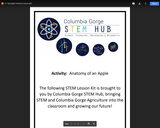
Children creat a 3 dimensional model of various constellations to learn how 2d images are actually 3d.
- Subject:
- Astronomy
- Physical Science
- Material Type:
- Activity/Lab
- Provider:
- Astronomical Society of the Pacific
- Date Added:
- 08/08/2022

Children creat a 3 dimensional model of various constellations to learn how 2d images are actually 3d.

In this place-based lesson, students will dissect an apple fruit to learn more about its different parts. Includes activity instructions, extension activities, songs and rhymes, anatomy of an apple student worksheet, and sink or float student worksheet.
NGSS: K-ESS3-1, 1-LS1-1
Time: 30 minutes
Materials: "Apples Grow on Trees" or other book about apples, knife, cutting board, at least three apples, apple parts tray, and apple dissection worksheet.

This hands-on workshop explores the tool Atelier that was developed to support feedback in programming tutorials. Our teaching philosophy for programming is based on a tinkering approach, that is characterised by playful exploration, driven by curiosity. Students define from the start their own assignments, given only a set of ingredients to use. The role of a teacher is to provide starting points, explain the first steps to take, and to get students unstuck when necessary. This approach puts students in a very active position but is also very feedback intensive.To support giving feedback and to reduce inconsistencies in feedback given by teaching assistants (TAs), we developed a tool, Atelier, that allows to give comments on code and share this with the respective student, and also with TAs and teachers.The hands-on activity will start with an introduction, followed by an online tutorial lecture with some simple programming assignments. Participants will take the role of students as well as TAs and use Atelier to give and receive feedback. After two rounds of programming exercises, we will evaluate the tool with the participants and discuss its use and place in programming education.

Children match pictures of the Moon on cards with matching pictures on a banner that shows the Moon phase cycle.

Accompanying resource to "Bear Shadow Activity." Children learn how the location of a light source changes how shadows appear.

Children design and build a vehicle for exploring another world, using recycled materials.

Children love to sing! Constellation Song is easy to sing, and scientifically accurate!

Students compress the age of the universe to a 12 month calendar to understand how old the universe is, and get a sense of the cosmic time scale.

In this activity we want families to start thinking about the Moon as a real place. There is no right answer to the challenge, although some answers are better than others. The activity helps families to think about the environment on the Moon so they can determine what they would need for survival on the lunar surface. Families pick items from a list provided, those they want to keep to help survive a crash landing on the Moon. Teamwork is essential in this activity since different members of the family may know different things about either the Moon or science. By pooling their knowledge, families are more likely to come up with the best answers.

Children make craters by dropping balls into a tub of flour.

Children talk about the differences between daytime and nighttime, including the activities they do at each time.

Children will create a miniature model of the Earth and moon to understand how eclipses happen.

Many people hold preconceptions about the reasons behind the phases of the Moon. Many think the phases are caused by the shadow of the Earth on the Moon or by shadows passing in front of the Moon. This activity creates a model with the real Moon and Sun in the sky to help participants discover the real reason for the lunar phases.

Children work together in a group to create an Earth landscape, compare different environments on Earth, and talk about what makes Earth special.

Students are divided into groups and, after being introduced to galaxies in general, are given 20 galaxy images to sort into categories of their own devising. The groups then compare notes about their sorting criteria and learn more about what the different visual characteristics of galaxies imply.

Children use binoculars to search for small items that an astronaut lost while walking on the Moon.

Students explore the height of various things between sea level and space to understand the scale of the atmosphere.

Students recreate one of Galileo's experiments that charted Jupiter's moon to get a better understanding of the scientific method.

Children create their own space helmets out of paper bags, put on special air packs, gloves, and boots, and then explore the lunar landscape.

A high-resolution PDF that can be used to create a poster that illustrates the phases of the moon.